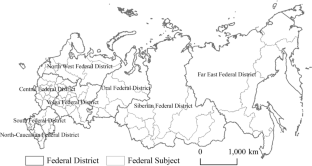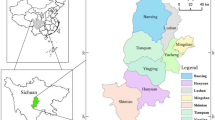Abstract
Under the background of “the Belt and Road” and “the economic corridor of China, Mongolia and Russia” initiatives, it is of great significance to study the temporal and spatial evolution characteristics of urbanization in Russia. This paper studied the population urbanization level, economic urbanization level, social urbanization level, eco-environment urbanization level, and their coupling coordination development degree during 2005–2020 in Russia. First, combining with the Population-Economic-Sociology-Eco-environment model, the paper constructed the index systems to evaluate the urbanization development levels in Russia. Second, based on the comprehensive weighting method of entropy weight and variation coefficient, this paper calculated the population urbanization level, economic urbanization level, social urbanization level, and eco-environment urbanization level in Russia. Third, this paper used the coupling coordination model to measure the coupling coordination degree of the urbanization development levels in Russia. Finally, the spatial differentiation of the population urbanization level, economic urbanization level, social urbanization level, eco-environment urbanization level, and their coupling coupling-coordination degree was performed, respectively, by using ArcGIS. The results are as the following. First, from 2005 to 2020, the economic urbanization level and eco-urbanization level have shown the increasing trend in Russia. The population urbanization level and social urbanization level have shown the stable changing trend in Russia. The eco-environment urbanization and economic urbanization contribute larger share to the urbanization system compared with the population urbanization and social urbanization. The coupling coordination development degree of population urbanization level, economic urbanization level, social urbanization level, and eco-environment urbanization level has showed a slight increasing trend. However, the overall situation of the urbanization in Russia is still in the moderate uncoordinated recession stage. Second, the federal subjects with high urbanization development levels are mainly distributed in Moscow city, Moscow Region, Sverdlovsk Region, Tumen Region, Saint-Petersburg city, Republic of Tatarstan, Krasnoyarsk Territory, Republic of Bashkortostan, Chelyabinsk Region, Nizhny Novgorod Region, Krasnodar Territory, Rostov Region, and Khanty-Mansiysky Autonomous Area. The federal subjects with low ones are mainly located in Republic of Khakasia, Republic of Marii El, Republic of Kabardino-Balkaria, Republic of Tyva, Republic of Karachaevo-Cherkessia, Republic of Kalmykia, Republic of Altay, Jewish Autonomous Area, and Republic of Ingushetia. Third, spatially, from 2005 to 2020, the urbanization pattern of population, economy, society, eco-environment, and their coupling coordination degree in Russia all show unbalanced development characteristics. The population urbanization pattern and the social urbanization pattern have not changed significantly, showing the spatial characteristics of “high west, low east,” and “high middle, low north, low south.” The economic urbanization pattern has been increasing significantly, showing the spatial characteristics of “high core, low edge.” The eco-environment urbanization pattern has not changed significantly, showing the spatial characteristics of “high north, low south.” The coupling coordinated development degree of urbanization pattern has showed a slight increasing trend, showing the spatial characteristics of “high middle, low north, low south,” “high west, low east”. Finally, we suggest policies and strategies that can boost the growth and development of the urbanization in Russia.






Similar content being viewed by others
Data availability
Some or all data, models or codes that support the findings of this study are available from the corresponding author upon reasonable request.
References
Chu NC, Zhang PY, Wu XL, Li H (2021a) Measurement and spatial differentiation of urbanization development in Russia. World. Reg Stud 30(2):257–266
Chu NC, Zhang PY, Wu XL, Li H, Yang QF (2021b) Spatiotemporal evolution characteristics of coordinated development between urbanization and ecological environment in eastern Russia. Acta Ecol Sin 41(24):9717–9728
Feng CP (2014) Urban development of Russia and its role in regional economy. World Reg Stud 23(2):59–68
Gao JX (2014) Urbanization and urban development in Russia. Russian, East Eur Central Asian Stud 1:38–45+96
Geng XT (2008) Study on the urbanization of the Soviet Union. Heilongjiang Provincial Academy of Social Sciences 5–7
Guo FY, Tong LJ, Liu ZG, Zhao HJ, Hou AL (2019) Spatial-temporal pattern and influencing factors of industrial ecology in Shandong province: based on panel data of 17 cities. Geogr Res 38(9):2226–2238
Guo FY, Lv X, Yu W, Ren JM, Chu NC (2020) Performance evaluation and driving mechanism of green development in Shandong Province based on panel data of 17 cities. Sci Geogr Sin 40(2):200–210
Guo FY, Tong LJ, Qiu FD, Li YM (2021) Spatio-temporal differentiation characteristics and influencing factors of green development in the eco-economic corridor of the Yellow River Basin. Acta Geograph Sin 76(3):726–739
Kolomak EA (2015) Evolution of spatial distribution of economic activity in Russia. Reg Res Russ 5(3):236–242
Kuleshov VV, Seliverstov VE (2018) Role of Siberia in Russia’s spatial development and its positioning in the strategy for spatial development of the Russian Federation. Reg Res Russ 8(4):345–353
Leksin VN, Porfiriev BN (2018) The Russian phenomenon of megalopolis-type cities. Reg Res Russ 8(2):133–140
Li YF, Li Y, Zhou Y, Shi YL, Zhu XD (2012) Investigation of a coupling model of coordination between urbanization and the environment. J Environ Manag 98:127–133
Liu WD (2015) Scientific understanding of the Belt and Road Initiative of China and related research themes. Prog Geogr 34(5):538–544
Liu C, Deng M, Ran CH (2017) Research on the coordinated development of agricultural modernization and new urbanization in Northeast China. China Popul Resources Environ 27(6):155–162
Liu WD, Song ZY, Liu ZG, Yeerken W, Song T, Niu FQ, Han MY (2018) Progress in research on the Belt and Road Initiative. Acta Geograph Sin 73(4):620–636
Lu DD (2018) Scientific understanding of “the belt and the road”. Sci Technol Rev 36(3):1
Suspitsyn SA (2015) Measurements in the space of regional indicators: methodology, techniques, and results. Reg Res Russ 5(3):223–235
Wan YK, Dong SC, Wang F, Li ZH, Li FJ, Li J (2013) Research on the regional economic discrepancy of eastern Russian. Geogr Res 32(10):1890–1898
Yu L, Qiu XP (2006) Study on the urbanization process of Russia since the transition. Russ Stud 2:52–57
Zhang ZH (2003) Characteristic and historical origins of Russian urbanization in Soviets period. J Hist Sci 5:97–103
Zhikharevich BS, Rusetskaya OV (2018) Fluctuations in the relative dynamics of development of Russia’s regional centers in 2003-2013. Reg Res Russ 8(1):34–45
Funding
This research was funded by National Natural Science Foundation of China (42101165, 42071162), China Heilongjiang Philosophy and Social Sciences Research Planning Project (21JLC201), China Postdoctoral Science Foundation (2021M693817), and China Heilongjiang Postdoctoral Science Foundation (LBH-Z21067).
Author information
Authors and Affiliations
Contributions
Conceptualization, literature search, original draft, and editing were done by Nanchen Chu. Xiangli Wu provided the necessary resources to improve the manuscript and Pingyu Zhang reviewed the manuscript.
Corresponding author
Ethics declarations
Ethics approval
Not applicable.
Consent to participate
Not applicable.
Consent for publication
Not applicable.
Competing interests
The authors declare no competing interests.
Additional information
Responsible Editor: Philippe Garrigues
Publisher’s note
Springer Nature remains neutral with regard to jurisdictional claims in published maps and institutional affiliations.
Rights and permissions
About this article
Cite this article
Chu, N., Zhang, P. & Wu, X. Spatiotemporal evolution characteristics of urbanization and its coupling coordination degree in Russia — perspectives from the population, economy, society, and eco-environment. Environ Sci Pollut Res 29, 61334–61351 (2022). https://doi.org/10.1007/s11356-022-20215-z
Received:
Accepted:
Published:
Issue Date:
DOI: https://doi.org/10.1007/s11356-022-20215-z




